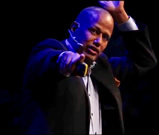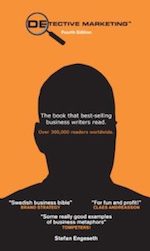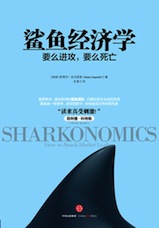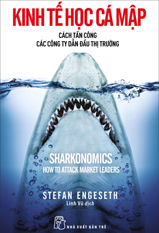In the war industry they build brands to scare. They attract buyers by building scary brands – F16 is not only a war aircraft its a brand that scars its enemy of to back off. The fear factor also work for brands as Harley-Davidson.
The fear factor in branding is working like a magnet (the gravity force works in both ways).
What is the fear factor for: insurance, Jeep, holidays, traveling etc?
A company that has managed to make the product its spokesman is Apple. The company’s computers replaced the square, grey, box that was once mandatory for all computers with unique modern design and vibrant colours. The computers gave consumers personality and colour. In return, consumers gave Apple enthusiastic fans. I have had an Apple since the Mac Plus in the 80’s. I’ve always wondered why most of Apple’s best advertising addresses people who’ve been using the product for a long time rather than to first time users? Can a product be superior without succeeding? My laptop is attracting admiring looks as I write this sitting at a cafe. This product creates story-telling. Apple’s Macintosh has what many consider a superior operating system, superior hardware, superior design and a brand image that is practically an icon. Yet, Apple has never managed to capture more than 5-10% of the PC market. Why?
Seth Godin is pointing out a “brick by brick” solution on his blog today:
“If you are swinging for the fences all the time, looking for one, you might end up striking out a lot. Bricks, on the other hand, are the way most industries are won.” Seth Godin
I have seen a switcher in real life. One of my friends who was a PC lover and an Apple hater, bought an iPod (a good switcher product). He was so taken with the product that he later bought an Apple computer as well. I couldn’t resist sending him a basket of fresh apples.
Apple could broaden its business even more than with just the iPod. Dell is expanding into all sorts of business areas with great success and Apple could do the same or better. In every home, a switch is imminent from the old boxes we called TV’s to new digital technology. The home TV market is changing and the time is right for Apple to take a share of that market. Millions of people already have home cinema equipment (DVD, surround sound), but the big screen projection is not particularly impressive.
How can brands sell their offer brick by brick ore as a switcher product?
Summertime and swimming is a good combination. Swimming and bloging is perfect combination in my experience. What I mean is that when I swim al my creative thinking is so good processed, that swimming save me time. After swimming an hour, I have at least one weeks work done. Don’t tell this to my consulting client for they will then only pay me for swimming (but it would be quite cool to be a professional swimmer).
Water is a perfect think tank for open minds in a transparent market.
Here is a way for you to make your swimming time to become “a creative water workshop:”
Public swimming pools are often divided into a number of lanes based on different activities: training, exercise, instruction, diving, etc. The customers are the ones that make the system work. They all have different needs, yet they all share the same water. Here there are endless parallels with the marketplace.
I don’t take responsibility for your safety ore others around in the swimming pool. But it would be great to read your test report from the water workshop.
It sounds like science fiction but the toy industry is right now looking in to how toys can be physical connected with kids. This means that kids don’t need to use their hands ore even their eyes to play with this future toys. Why are the toy industries doing this? Kids are more open for new things (they want to be more extreme than their parents ware at their age). Toys are BIG money so they have resources for research. Traditional toy manufactures need to fill the gap between “old traditional toys” and “computer games.” Kids are the wildest and fastest target group on earth when it comes to BUZZ around a new product.
Evolution and Revolution is connected
Lets look at an idea how it could look at an introduction of the toys. Lets say Harry Potter is going to release a new movie. Lets start with invited 500 kids in the 200 biggest cities in the world for the premier night. They al sit down together with some reporters that like to share the experience with the rest of the world. When they enter the cinema, they do get a new toy that connect to their brain. The movie starts but there is nothing on the cinema screen (everything is coming from the new toy machine direct into the kids senses). It will be a total illusion. Kids don’t then watch Harry Potter, they a part of the story and can choose to be Harry ore somebody else in the story. If they like to see the film as a game they can choose level of interaction with the movie. This means that you can be a part of the cinema. I guess the problem with mobiles phones sounds in the cinema is gone…
This kind of research is being done right now (secret sources). I wont go in to all the complicated issues when it comes to the ethical part of doing this toy machines. It is a dangerous road, where fantasy and reality can be mixed up for the kids. But at the same time some evolution theories are pointing out that homo sapiens wont develop if we don’t get mixed with a computer ore some other animals (think parents prefer computers).
Today’s toys are anti-creative
When I was a kid I did not always had al the toys needed to play whatever felt to play for the moment. Then I used cheers as cars and other stuff around in the house. I believe this is one of the reasons for why I developed my fantasy and are today working with workshops and make CEOs play on new markets. The toys that we did use back in the days where more of a box that you could get out of the box with (a build what you like concept). But if you go to a toy store today you will find a lot of boxes locked in “build this x model only” concept, with a total fantasy free handbook how to build it. This kids are growing into work life some of them will need a handbook ore maybe a lot of creative workshops to get business moving.
Today products are only tomorrow’s museum
If the new toys hit the market with a build in connection to kids brains then tomorrow’s workplace is going to be an interesting and creative business place. It would also make today’s computers, mobiles and other product to belong to a museum. I guess for most of us it would be the same situation as the grand old lady I was talking to at the train yesterday: “I could not believe that the television was real when I fist heard of it. Real moving pictures in our home.”
When will Harry Potter release this kind of “brain connect” movie? How will computers and mobiles etc work then? Is this marketer’s dream, when they can build top of mind brands inside our heads? What do you think of the ethical issues of this new toys future? What do you think of the lady on the train? What were your favorite toys? Did you toys develop you creative thinking as a kid? MacDonald’s are spreading more toys than anyone on the earth, how will they mix the commercial needs with the ethical issues do you think?
We’re all egoists (maybe not you and me, but everyone else) and we all want to live in paradise. To sell to the egoist in us, a brand has to create a bit of that paradise. What most brands forget is that paradise building goes on long after the act of consumption. No one wants to sit all alone with his or her wonderful telephones, faxes, and computers. Everyone wants to play with those toys, yet it isn’t the toy that’s the main thing; it’s the play. Everyone wants someone to interact with; everyone wants the positive brand experience to continue.
Are companies out after a divorce, with their consumers?
When you get married you get a ring on your finger, a symbol that helps make the act more concrete. In the corporate world, however, the company’s interest lasts as long as the act of
consumption. After that, the company doesn’t want to hear from you and will only talk to you if you have a complaint – a bit like the tail end of a bad marriage.

Yesterday was the grand finale at the Pride parade in Stockholm 35.000 joined the parade in colors from the rainbow and 350.000 in the audience open their mind and become ONE. Gay pride is a big movement in changing minds (and that’s why it started). This year it was full of gay tourist that did spend their money in Stockholm (pink money). The commercial level of this parade is growing because of the visible money (new media channels etc) that the guy community is investing in brands.
The tin opener for the gay community to attract the corporate world started as pink but wild end in the colors of the rainbow.
ONE reader Lars Johansson did send me the photo above and with good input from the festival (thanks Lars). Brands like IKEA and MER (more) did make slogans that were talking to the community direct: “Get in to the wardrobe” and “Make love MORE.” I think that the level of the money is so big that most marketing managers should soon be dressed in pink.
How can different organizations learn from pride parade? Is the commercial level going to growing from green to rainbow colors in al markets? Is the best concept the ONE everybody can dance to?
Monkeys don’t go to gym, for they live as ONE with their nature of their surroundings. Even if I as a consultant sometimes am working as a “gym trainer” for CEOs I rather set them free in to the nature where they belong. When they let the monkey in them go fee and climb, seeing and feeling what’s out their with their consumers, they will become ONE with nature of business.
Is the reality to complicated then the Zoo at the boardroom?
An example is products that are connected with the great outdoors. The relationship is not always visible in the city, nor are the activities of environmental groups tangible. It is only when there is a concrete connection to what these groups are trying to protect, that a genuine response and true commitment can be inspired.
The difference between a monkey and a human is only around 1%. It is even less between a CEO and a consumer.
Showroom Naturelle
Manufacturers of sporting goods, outdoor clothing, fishing equipment, jeeps and the like have a strong need to communicate on a concrete level. Even nature reserves and national forests can be marketing in a more tangible way. A showroom can be built at a subway station or an airport. The showroom could feature a real forest with live animals and a babbling brook. Climate and genuine forest sounds can be simulated in realistic manner. From the subway with fluorescent lighting straight into the woods. There can be “moose crossing” signs posted around town along with teasers reading: “Deer have been sighted in the subway!”
When the country literally comes to the city, more big city people will become aware of the importance of a clean environment.
The total market for all participating companies would increase proportional to the amount of increased environmental consciousness. Environmental groups can communicate that this is something we all must work together to solve. The target group is active people, that is, people in motion and these people are most easily reached in a subway or at the airport. Where there is movement, there is also consciousness. When consciousness is affected new forms of communications are created.
Experiences in showrooms show conscious or sub-conscious needs which lead to new patterns of consumption.
Other countries’ tourist boards could use showrooms in subways to build miniature replicas of their respective countries. One week Turkey, the next, Tanzania. The idea is to wake curiosity and a longing to see the country for oneself. What values are created when the subway company can advertise: “We can take you around the world, one flight down”?
I leave it to the reader to ponder the implications.
So way pay does CEOs pay for the gym?
Even since Adam Smith & co have companies try to find short cuts. I believe that they soon also will have their own military. Some already have it (they rent it). Because of terror and criminal elements are security so critical part of big business that it needs to be a part of the company. This means that they will need an “in-house” army to secure and control the “sell force” etc. It may sound cynical but many have already their own “in-house secret service department,” a specially branches with big money as the car industry, IT etc.
Back in the 1980 I called the big blue about an innovation I waned to show for them, the security chief called me back and asked if I hade something against the USA! I don’t think so I only hade an innovation I wanted to discuses… before this call (today the innovation is standard on the market).
It is a bit like the legendary movie “The Lord Of The Rings” where the good and bad fore in the world fight. It would feel strange with some bad “corporate army” running around in Mordor to secure profit.
The above scenario is more than possible if not the corporate world open up and lock it self in a fix reality (where only profit is the goal). By open up for consumers they will act and be more healthy way of doing business. Nothing wrong with profit but is their really any profit without consumers?
When did Bill G say, “The only thing we don’t have is our own army”? Will does army’s have brands on their dresses? Is industry espionage using traditional army’s for the profit of the countries business (airplane etc)? Is this a future we really want?
Brands do connect to consumers feeling and are making emotional relations. And they do speak as persons with personality like “How are you?” Vodaphone. Then they kill the brand and put it in an emotional gravyard they call fusion. But most brand fusion is badly done because of the distance to the consumer is so far that they cant change the relation to “I am I a lost brand”? Phoneoff.
Maybe it sounds a bit cynical to call it a “brand graveyard” but if you start putting numbers into what’s is laying in this graveyard, you will start wondering how many billions of dollars there is. I think many brand managers would start to dig up billions of dollar if they see how ONE many of this brands still are with consumers (that still mourn them strongly).
“Brands are born and thrive on their strength to create, build, and keep loyal customers. The effective maintenance of brand leadership requires constant care and feeding. Failure to nurture your brand destines it to join other failed brands in the brand graveyard.” Len Johnson
Witch is the brands you would like to put to life again? Witch is the brands that are most old and seen in films (product placements)? Are there still fans to some of the brands in the “brand graveyard”?

















